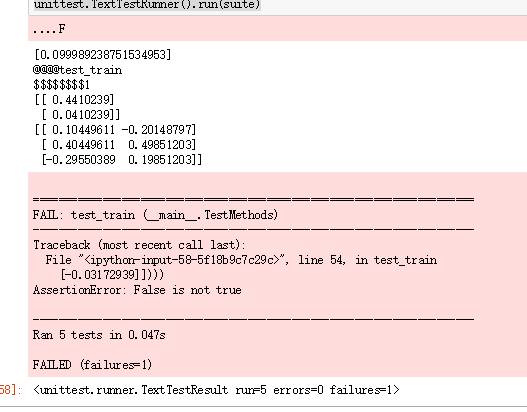手写串行BP算法,可调batch_size
既要:1、输入层f(x)=x 隐藏层sigmoid 输出层f(x)=x
2、run函数实现单条数据的一次前馈
3、train函数读入所有数据for循环处理每条数据。
循环中:
首先调用run函数,得到各层的值
self.input_nodes_value
self.hidden_nodes_value
self.output_nodes_value
然后计算输出层误差和delta
4、关键函数:用于前馈的sigmoid和用于反馈的sigmoid的导数
self.activation_function = lambda x : 1/(1+np.exp(-x)) # sigmoid函数,用于正向传播
self.delta_activation_function = lambda x: x-x**2 # sigmoid一阶导,用于反向传播
5、反向传播
使用梯度下降方法
下面是推导隐藏层(实际上为relu层)到输出层的权重w[h][o]的梯度下降公式的过程,对应的几个变量在下面的代码中用红色标出
关于梯度下降公式推导:
https://blog.csdn.net/wfei101/article/details/80807749
https://www.jianshu.com/p/17191c57d7e9

batch_size=1 # 输入层没有激活函数f(x)=x,隐藏层激活函数sigmoid,输出层激活函数f(x)=x class NeuralNetwork(object): def __init__(self, input_nodes, hidden_nodes, output_nodes, learning_rate): # 各层节点个数 self.input_nodes = input_nodes self.hidden_nodes = hidden_nodes self.output_nodes = output_nodes # 创建三个一维数组存放三层节点的值 # print(str(self.input_nodes)+" "+str(self.hidden_nodes)+" "+str(self.output_nodes)) self.input_nodes_value=[0.0]*input_nodes self.hidden_nodes_value=[0.0]*hidden_nodes self.output_nodes_value=[0.0]*output_nodes # Initialize weights self.weights_input_to_hidden = np.random.normal(0.0, self.input_nodes**-0.5, (self.input_nodes, self.hidden_nodes))#输入层>>隐藏层权重矩阵 self.weights_hidden_to_output = np.random.normal(0.0, self.hidden_nodes**-0.5, (self.hidden_nodes, self.output_nodes))#隐藏层>>输出层权重矩阵 self.learning_rate = learning_rate#学习率 self.activation_function = lambda x : 1/(1+np.exp(-x)) # sigmoid函数,用于正向传播 self.delta_activation_function = lambda x: x-x**2 # sigmoid一阶导,用于反向传播 self.change_to_fix_weights_h2o=[[0.0]*self.output_nodes]*self.hidden_nodes#存储隐藏层>>输出层权重调整量 self.change_to_fix_weights_i2h=[[0.0]*self.hidden_nodes]*self.input_nodes#存储输入层>>隐藏层权重调整量 # print("xxxx") # print(self.change_to_fix_weights_h2o) # print(self.change_to_fix_weights_i2h) def train(self, features, targets):#完成n条数据的一次前向传递和反向传递,每个batch调整一次权重矩阵 ''' features: 2D array, each row is one data record, each column is a feature targets: 1D array of target values ''' n=features.shape[0]#数据条数 # print(features) # print(targets) counter=batch_size for ii in range(0,n): self.run(features[ii])#调用前向传播 print(self.output_nodes_value) error_o=[0.0]*self.output_nodes#输出层误差 error_h=[0.0]*self.hidden_nodes#隐藏层误差 output_deltas=[0.0]*self.output_nodes hidden_deltas=[0.0]*self.hidden_nodes for o in range(self.output_nodes): # 输 出 层 error_o[o]=targets[ii][o]-self.output_nodes_value[o]#计算输出层误差 # output_deltas[o]=self.delta_activation_function(self.output_nodes_value[o])*error_o[o]#输出层反向传播(求导) output_deltas[o]=1*error_o[o]#输出层反向传播(求导) for h in range(self.hidden_nodes): # 隐 藏 层 for o in range(self.output_nodes): # print('weight::',self.weights_hidden_to_output[h][o]) error_h[h]+=output_deltas[o]*self.weights_hidden_to_output[h][o]#计算隐藏层误差 # print('....') # print(self.hidden_nodes_value[h]) # print(error_h[h]) hidden_deltas[h]=self.delta_activation_function(self.hidden_nodes_value[h])*error_h[h]#隐藏层反向传播 # print(hidden_deltas[h]) for h in range(self.hidden_nodes): for o in range(self.output_nodes): self.change_to_fix_weights_h2o[h][o]+=output_deltas[o]*self.hidden_nodes_value[h]#累计隐藏层>>输出层的权重矩阵的调整量 for i in range(self.input_nodes): for h in range(self.hidden_nodes): # print("......") # print(hidden_deltas[h]) # print(self.input_nodes_value[i]) # print(self.change_to_fix_weights_i2h[i][h]) self.change_to_fix_weights_i2h[i][h]+=hidden_deltas[h]*self.input_nodes_value[i]#累计输入层>>隐藏层的权重矩阵的调整量 counter-=1 if counter==0:#完成一个batch的输入和计算后,调整一次权重 #调整隐藏层>>输出层权重 for h in range(self.hidden_nodes): for o in range(self.output_nodes): self.weights_hidden_to_output[h][o] += self.learning_rate*self.change_to_fix_weights_h2o[h][o] #调整输入层>>隐藏层权重 for i in range(self.input_nodes): for h in range(self.hidden_nodes): # print("......") # print(self.weights_input_to_hidden[i][h]) # print(self.learning_rate) # print(self.change_to_fix_weights_i2h[i][h]) self.weights_input_to_hidden[i][h] += self.learning_rate*self.change_to_fix_weights_i2h[i][h] # print(self.weights_input_to_hidden[i][h]) #将权值调整量归零,计数器复位,开始输入下一个batch self.change_to_fix_weights_h2o=[[0.0]*self.output_nodes]*self.hidden_nodes self.change_to_fix_weights_i2h=[[0.0]*self.hidden_nodes]*self.input_nodes counter=batch_size return self.weights_hidden_to_output def run(self, features):#完成一条数据的一次前向传递 ''' features: 1D array of feature values ''' # print(self.input_nodes_value) for i in range(self.input_nodes): self.input_nodes_value[i]=features[i] # self.input_nodes_value[i]=self.activation_function(features[i]) # print(self.input_nodes_value) # print(self.hidden_nodes_value) for h in range(self.hidden_nodes): temp=0 for i in range(self.input_nodes): temp+=self.input_nodes_value[i]*self.weights_input_to_hidden[i][h] temp=self.activation_function(temp) self.hidden_nodes_value[h]=temp # print(self.hidden_nodes_value) # print(self.output_nodes_value) for o in range(self.output_nodes): temp=0 for h in range(self.hidden_nodes): temp+=self.hidden_nodes_value[h]*self.weights_hidden_to_output[h][o] # temp=self.activation_function(temp) self.output_nodes_value[o]=temp # print(self.output_nodes_value) return self.output_nodes_value
单元测试:
import unittest inputs = np.array([[0.5, -0.2, 0.1]]) targets = np.array([[0.4]]) test_w_i_h = np.array([[0.1, -0.2], [0.4, 0.5], [-0.3, 0.2]]) test_w_h_o = np.array([[0.3], [-0.1]]) class TestMethods(unittest.TestCase): ########## # Unit tests for data loading ########## def test_data_path(self): # Test that file path to dataset has been unaltered self.assertTrue(data_path.lower() == 'bike-sharing-dataset/hour.csv') def test_data_loaded(self): # Test that data frame loaded self.assertTrue(isinstance(rides, pd.DataFrame)) ########## # Unit tests for network functionality ########## def test_activation(self): network = NeuralNetwork(3, 2, 1, 0.5) # Test that the activation function is a sigmoid self.assertTrue(np.all(network.activation_function(0.5) == 1/(1+np.exp(-0.5)))) def test_train(self): # Test that weights are updated correctly on training network = NeuralNetwork(3, 2, 1, 0.5) network.weights_input_to_hidden = test_w_i_h.copy() network.weights_hidden_to_output = test_w_h_o.copy() network.train(inputs, targets) print('@@@@test_train') print("$$$$$$$$1") print(network.weights_hidden_to_output) print(network.weights_input_to_hidden) # network.train(inputs,targets) # print("$$$$$$$$2") # print(network.weights_hidden_to_output) # print(network.weights_input_to_hidden) self.assertTrue(np.allclose(network.weights_hidden_to_output, np.array([[ 0.37275328], [-0.03172939]]))) self.assertTrue(np.allclose(network.weights_input_to_hidden, np.array([[ 0.10562014, -0.20185996], [0.39775194, 0.50074398], [-0.29887597, 0.19962801]]))) def test_run(self): # Test correctness of run method network = NeuralNetwork(3, 2, 1, 0.5) network.weights_input_to_hidden = test_w_i_h.copy() network.weights_hidden_to_output = test_w_h_o.copy() self.assertTrue(np.allclose(network.run(inputs[0]), 0.09998924)) suite = unittest.TestLoader().loadTestsFromModule(TestMethods()) unittest.TextTestRunner().run(suite)
结果:


结果虽然比较接近,但是代码比较丑陋,并没有用numpy的矩阵相乘,而是用for循环实现了矩阵乘法,代码复杂,而且都是串行的。